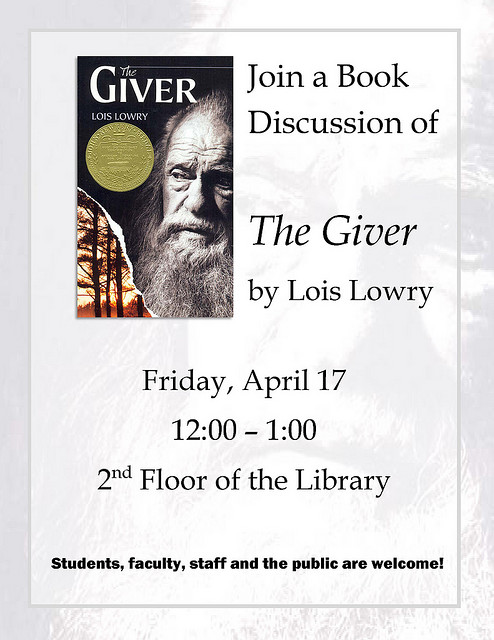The Giver, written by Lois Lowry, is a novel that stimulates deep thought’s about our world and the personal philosophy each of us holds about it. Sometimes taking a look back at a book written in older times can still be of extreme relevance today. This case is a great example of that, and should not be dismissed because of its publish date, some time in 1933.

A library still incorporating The Giver into their learning program. Taken by CACC North Library.
The book is based on a Utopian society where it practices the idea of sameness to keep a calm and quiet community. With this being the case, there are no emotions, color, feelings, climate, or temperature. This ensures no one feels anything they may be affected negatively by. There is one person in this town which is given the privilege of having a full range of normal emotion, feelings, etc. This person is called ‘The Giver‘ because they give knowledge of the real world to keep the society at peace. The book is about Jonas, a twelve year old boy is next in line to become the giver. As he discovers the truth about life and reality outside of the society, it becomes a big burden for him to carry. He is faced with many troubles about the quality of life his society is experiencing, and cannot discuss this matter with anyone. The more he learns about the real world, the harder the process is for him to continue. He eventually finds a way to escape, despite the strict conditions of the town.
This book is often incorporated into school’s reading programs, but in recent years, has been labeled as controversial. Some people believe this book teaches and has too much violence. I think the issue of whether or not Hemingway was sexist in his writing for this story is probably less of an issue There is also a mention of suicide by Jonas as he learns about the truth of life, and several parents find this to be dangerous for kids to read. The book still exists in many schools today, but the ban has also cut it from several others.
This book creates many of our own thoughts about the future time mentioned in this book. It allows us to think about our life, the joy and the pain. Yes, life could exist without both of those, but what would life be at that point? It makes us appreciate the experiences we have encountered throughout our life, and maybe have a new view at our philosophy of life. This is helpful for educational purposes, especially for middle school students. The positive results highly outweigh the negative, and people should appreciate the fresh perspective.
In the end of the book, Jonas is faced with the challenge of saving a baby brought to his family. The baby is to be released (killed) because of population issues. Jonas escapes with the baby, and is off to find a place called Elsewhere. He has to use the skills and memories he learned from the giver to try and survive. The end of the book leaves doubt as to whether Jonas has found Elsewhere, or if he is experiencing a memory. However, in an interview after the book was released, the author stated that Jonas had lived. This positive ending is much needed for a story of this intensity, especially for children.

